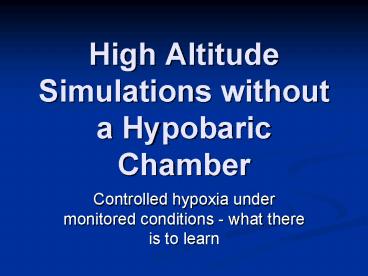High Altitude Simulations without a Hypobaric Chamber - PowerPoint PPT Presentation
1 / 27
Title: High Altitude Simulations without a Hypobaric Chamber
1
High Altitude Simulations without a Hypobaric
Chamber
- Controlled hypoxia under monitored conditions -
what there is to learn
2
Lecture goals
- Learn how a high altitude chamber is dangerous
and that a safer alternative is available - Learn how oxygen makes it from your cockpit to
your brain and how it applies to high altitude - Understand that we are all different, and that
one size does not fit all when it comes to oxygen
and high altitude
3
I - The chamber ride alternative
4
The past
- Can you spot the hypoxia monitor in this picture?
- (Hint, there are 9 of them)
- Hypoxia symptoms generally lead to neuronal damage
5
The evidence is there
Brief hypoxia-ischemia initially damages cerebral
neurons. Levy DE, Brierley JB, Silverman DG, Plum
F.
Early Effects of Hypoxia on Brain Cell
Function Kreimir Krnjeviæ Anaesthesia Research
Department, McGill University, Montréal, Quebec,
Canada
- Hypoxic Encephalopathy after Near-Drowning
Studied by Quantitative 1H-Magnetic Resonance
Spectroscopy Metabolic Changes and Their
Prognostic Value Roland Kreis, Edgard
Arcinue, Thomas Ernst, Truda K. Shonk, Ricardo
Flores, and Brian D. Ross
MR images (T1-weighted with TE 20 ms, repetition
time 600 ms) showing the inferior bounds of the
typical location of the regions of interest
studied as well as the morphologic changes after
ND as detected by MRI. MRI appears normal early
after ND (A) but reveals considerable cerebral
atrophy 3 mo after ND (B).
6
Modern setup
- NO ALTITUDE CHAMBER
- The subject is connected to 8 pulse oximeters for
the 20 minute session - He will be taken down ultimately to an 02
saturation of 70, that is approximately 18,000
feet - Brain damage is unlikely due to tight control
7
How we do it without a chamber
- High altitude simulation is achieved not by
changing barometric pressure (altitude chamber),
but by varying inhaled oxygen and nitrogen
concentrations.
8
How we control the environment
- The anesthesiologist controls the mixture of
gases given to the subject. He is also in charge
of resuscitation in case there is a problem - Compare to no monitoring in a high altitude
chamber (What I dont know wont hurt me???)
9
All that can hurt you is monitored
- All inhaled and exhaled gases are analyzed
- A gold standard pulse oximeter is used by the
anesthesiologist - Electrocardiogram
- Blood Pressure
- Exhaled carbon dioxide
- Arterial blood gases are sometimes sampled
10
Risk of Cardiac Arrhythmias
- A defibrillator is present since oxygen
deprivation often causes irregular heartbeats
which may lead to cardiac arrest
11
Exclusion Criteria
- We exclude subjects with any of the following
issues. - If you are flying high, take a close look at this
list!
12
Monitoring is non-invasive
- Easy setup
- In 5 minutes a subject is ready for the test
- Duration is some 20 minutes
13
An MD is in the back seat
- If an anesthesiologist were your copilot flying
in the back seat, this is what he would be
monitoring during your climb to the wave
14
II - Oxygen From the cockpit to your brain
15
How oxygen travels to your brain
16
Actual Changes at Different Pressure Altitudes
Table 3. Actual measured alveolar oxygen and
carbon dioxide concentrations at different
pressure altitudes. From Holmstrom, FMG Hypoxia.
In. Aerospace Medicine. Edited by HW Randall.
Baltimore. The Williams Wilkins Co., 1971. FT
Pressure Amb O2 Alv O2
CO2 0 760 159 103 40 5000 632 133 81 37 10000 5
23 110 61 35 12000 483 101 54 34 13000 465 97 51
33 14000 447 94 48 33 15000 429 90 45 32 20000
350 73 34 29 25000 282 59 30 27
17
O2-Hgb dissociation curve
98.5 of oxygen is carried in the blood, bound to
hemoglobin
Only 1.5 is dissolved in plasma
18
Curve Shifts
The curve shifts to the LEFT at altitude, because
of 1) decreased temperature, and 2)
hyperventilation that translates into lower CO2
and lower H (higher pH)
A shift to the left means the Hgb molecule will
take O2 more readily at altitude, but it will
inhibit its release into tissues (brain) even
with a normal O2 saturation
19
You do not react the same way every time you fly
- Because of these variations, oxygen must be used
early in flight to prevent accidents. A fixed
altitude for oxygen use does NOT exist.
20
Disease and O2 delivery
- Anemia
- Chronic Lung Disease
- Age
- Weight
- Heart Disease
- Carbon Monoxide poisoning
21
III - Examples
22
Minden Takeoff 4600
23
Kingsbury grade 9000
24
Mineral Peak 12500
25
Boundary Peak (return) 18000
26
Minden (return with O2)
27
Conclusions
- Because you dont have an MD in your backseat,
get to know yourself before you fly high - Oxygen must be started early to prevent a
complications from periodic variations in your
body - Starting oxygen early also allows you to test the
integrity of your equipment at a time when its
safe - Flight physicals, even though not required by the
FAA are encouraged in order to establish your
risk level - Have a backup plan if your main oxygen system
fails - Make sure you are breathing 100 oxygen, and not
a mixture or something else - Close the loop with a pulse oximeter!

